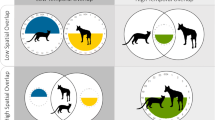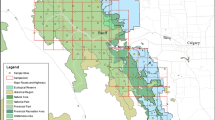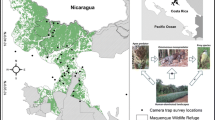Abstract
Spatiotemporal heterogeneity in the distribution of resources, interspecific competition and predation are important factors determining the spatial distribution and co-occurrence of many animal taxa. Here, we use data from scent station field studies and permutation-based null model analyses to test whether spatial co-occurrence of different carnivores’ species is non-random in a Central European landscape that has been strongly modified and fragmented through human activity. In general, our results suggest a higher degree of spatial co-occurrence of different carnivore species than expected by chance; though it should be noted that this difference was not detectable under the conservative form of the null model. On the other hand, our data do not provide evidence for a significant degree of spatial segregation at the interspecific level. In conclusion, our results imply that antagonistic interactions, such as interspecific competition and predation, are not the dominant factors shaping spatial distribution of carnivores. Consequently, we suggest that the high degree of spatial co-occurrence might be a consequence of spatial heterogeneity in distribution of resources that are shared at the interspecific level.
Similar content being viewed by others
References
Anděra M, Horáček I (2005) Poznáváme naše savce (get to know our mammals). Sobotáles, Praha (in Czech)
Azeria ET, Fortin D, Lemaitre J, Janssen P, Hebert C, Darveau M, Cumming SG (2009) Fine-scale structure and cross-taxon congruence of bird and beetle assemblages in an old-growth boreal forest mosaic. Global Ecol Biogeogr 18:333–345
Azeria ET, Ibarzabal J, Hebert C (2012) Effects of habitat characteristics and interspecific interactions on co-occurrence patterns of saproxylic beetles breeding in tree boles after forest fire: null model analyses. Oecologia 168:1123–1135
Barratt DG (1997) Predation by house cats, Felis catus (L.), in Canberra, Australia. I. Prey Composition and Preference. Wildlife Res 24:263–277
Bateman PW, Fleming PA (2012) Big city life: carnivores in urban environments. J Zool 287:1–23
Bertolino S, Dore B (1995) Food habits of the Stone Marten Martes foina in “La Mandria” Regional Park (Piedmont Region, North-Western Italy). Hystrix 7:105–111
Blaum N, Rossmanith E, Popp A, Jeltsch F (2007) Shrub encroachment affects mammalian carnivore abundance in arid rangelands. Acta Oecol 31:86–92
Boucníková E, Kučera T (2005) How natural and cultural aspects influence land cover changes in the Czech Republic? Ekológia 24:69–82
Červinka J, Šálek M, Pavluvčík P, Kreisinger J (2011) The fine-scale utilization of forest edges by mammalian mesopredators related to patch size and conservation issues in Central European farmland. Biodivers Conserv 20:3459–3475
Červinka J, Šálek M, Padyšáková E, Šmilauer P (2013) The effects of local and landscape-scale habitat characteristics and prey availability on corridor use by carnivores: a comparison of two contrasting farmlands. J Natur Conserv 21(2):105–113
Connor EF, Simberloff D (1979) The assembly of species communities: Chance or competition? Ecology 60:1132–1140
Creel S, Creel NM (1996) Limitation of African wild dogs by competition with larger carnivores. Conserv Biol 10:526–538
Crooks KR (2002) Relative sensitivities of mammalian carnivores to habitat fragmentation. Conserv Biol 16:488–502
Crooks KR, Soulé ME (1999) Mesopredator release and avifaunal extinctions in a fragmented system. Nature 400:563–566
Davis ML, Kelly MJ, Stauffer DF (2011) Carnivore co-existence and habitat use in the Mountain Pine Ridge Forest Reserve, Belize. Animal Conserv 14:56–65
Dice LR (1945) Measures of the amount of ecologic association between species. Ecology 26:297–302
Doncaster CP, Macdonald DW (1997) Activity patterns and interactions of red foxes (Vulpes vulpes L.) in Oxford city. J Zool 241:73–87
Elmeros M (2006) Food habits of stoats Mustela erminea and weasels Mustela nivalis in Denmark. Acta Theriol 51:179–186
Elmhagen B, Ludwig G, Rushton SP, Helle P, Lindén H (2010) Top predators, mesopredators and their prey: interference ecosystems along bioclimatic productivity gradients. J Anim Ecol 79:785–794
Faaborg J, Brittingham M, Donovan T, Blake J (1993) Habitat fragmentation in the temperate zone: A perspective for managers. In: Finch DM, Stangel PW (eds) Status and management of neotropical migratory birds, US Forest Service General Technical Report, pp. 331–338
Ferreira JP, Leitão I, Santos-Reis M, Revilla E (2011) Human-related factors regulate the spatial ecology of domestic cats in sensitive areas for conservation. PLoS One 6(10):e25970. doi:10.1371/journal.pone.0025970
Gehring TM, Swihart RK (2003) Body size, niche breadth, and ecologically scaled responses to habitat fragmentation: mammalian predators in an agricultural landscape. Biol Conserv 109:283–295
Genovesi P, Secchi M, Boitani L (1996) Diet of stone martens: an example of ecological flexibility. J Zool 238:545–555
Germain E, Benhamou S, Poulle ML (2008) Spatio-temporal sharing between the European wildcat, the domestic cat and their hybrids. J Zool 276:195–203
Gittleman JL, Harvey P (1982) Carnivore home-range size, metabolic needs and ecology. Behav Ecol Sociobiol 10:57–63
Goldyn B, Hromada M, Surmacki A, Tryjanowski P (2003) Habitat use and diet of the red fox Vulpes vulpes in an agricultural landscape in Poland. Z Jagdwiss 49:191–200
Gompper ME, Kays RW, Ray JC, LaPoint SD, Bogan DA, Cryan JR (2006) A comparison of non-invasive techniques to survey carnivore communities in Northeastern North America. Wildlife Soc B 34:1142–1151
Goszczyński J, Jędzejewska B, Jędrzejewski W (2000) Diet composition of badger (Meles meles) in a pristine forest and rural habitats of Poland compared to other European populations. J Zool 250:495–505
Gotelli NJ (2000) Null model analysis of species co-occurrence patterns. Ecology 81:2606–2621
Gotelli NJ, McCabe DJ (2002) Species co-occurrence: a meta-analysis of J. M. Diamond’s assembly rules model. Ecology 83:2091–2096
Hanski I (2008) Spatial patterns of coexistence of competing species in patchy habitat. Theor Ecol 1:29–43
Harrington LA, Harrington AL, Yamaguchi N, Thom MD, Ferreras P, Windham TR, Macdonald DW (2009) The impact of native competitors on an alien invasive: temporal niche shifts to avoid interspecific aggression. Ecology 90:1207–1216
Helldin JO, Liberg O, Gloersen G (2006) Lynx (Lynx lynx) killing red foxes (Vulpes vulpes) in boreal Sweden: frequency and population effects. J Zool 270:657–663
Jaccard P (1901) Étude comparative de la distribution florale dans une portion des Alpes et des Jura. B Soc Vaud Sci Natur 37:547–579
Jêdrzejewski W, Jêdrzejewska B (1992) Foraging and diet of the red fox Vulpes vulpes in relation to variable food resources in Bialowieza National Park, Poland. Ecography 15:213–221
Jêdrzejewski W, Jêdrzejewska B, Zub K, Nowakowski WK (2000) Activity patterns of radio-tracked weasels Mustela nivalis in Białowieża National Park (E Poland). Ann Zool Fenn 37:161–168
Johnson WE, Fuller K, Franklin WL (1996) Sympatry in canids: a review and assessment. In: Gittleman JL (ed) Carnivore behavior, ecology, evolution. Cornell University Press, Ithaca
Kowalczyk R, Jêdrzejewska B, Zalewski A (2003) Annual and circadian activity patterns of badgers Meles meles in Białowieża Primeval Forest (E Poland) compared to other Palaearctic populations. J Biogeogr 30:463–472
Lanszki J, Heltai M (2007) Diet of the weasel in Hungary. Folia Zool 56:109–112
Lenth BE, Knight RL, Brennan ME (2008) The effects of dogs on wildlife communities. Nat Areas J 28:218–227
Linhart SB, Knowlton FF (1975) Determining the relative abundance of coyotes by scent station lines. Wildlife Soc B 3:119–124
Linnell JDC, Strand O (2000) Conservation implications of aggressive intra-guild interactions among mammalian carnivores. Divers Distrib 6:169–176
Lipský Z (2000) Historical development of the Czech rural landscape: implications for present landscape planning. In: Richling et al. (eds) Landscape ecology: theory and applications for practical purposes. The Problems of Landscape Ecology, Warsaw
Lloyd P (2007) Predator control, mesopredator release, and impacts on bird nesting success: a field test. Afr Zool 42:180–186
Lodé T (1995) Activity pattern of polecats Mustela putorius L. in relation to food habits and prey activity. Ethology 100:295–308
Long RA, McKay P, Zielinski WJ, Ray JC (2008) Noninvasive survey methods for carnivores. Island Press, Washington DC
Lozano J, Virgós E, Malo A, Huertas DL, Casanovas JG (2003) Importance of scrub-pastureland mosaics on wild-living cats occurrence in a Mediterranean area: implications for the conservation of the wildcat (Felis silvestris). Biodivers Conserv 12:921–935
MacDonald DW, Tew TE, Todd IA (2004) The ecology of weasels (Mustela nivalis) on mixed farmland in southern England. Biologia 59:235–241
Mangas JG, Lozano J, Cabezas-Diaz S, Virgós E (2008) The priority value of scrubland habitats for carnivore conservation in Mediterranean ecosystems. Biodivers Conserv 17:43–51
Martinoli A, Preatoni DG, Reatoni B, Chiarenzi B, Tosi G (2001) Diet of stoats (Mustela erminea) in an Alpine habitat: the importance of fruit consumption in summer. Acta Oecol 22:45–53
McDonald RA (2002) Resource partitioning among British and Irish mustelids. J Anim Ecol 71:185–200
McDonald RA, Webbon C, Harris S (2000) The diet of stoats (Mustela erminea) and weasels (Mustela nivalis) in Great Britain. J Zool 252:363–371
McDonald RA, O’Hara K, Morrish DJ (2007) Decline of invasive alien mink (Mustela vison) is concurrent with recovery of native otters (Lutra lutra). Divers Distrib 13:92–98
Mortelliti A, Boitani L (2007) Evaluation of scent-stations surveys to monitor the distribution of three European carnivore species (Martes foina, Meles meles, Vulpes vulpes) in a fragmented landscape. Mammal Biol 73:287–292
Moruzzi TL, Fuller TK, DeGraaf RM, Brooks RT, Li WJ (2002) Assessing remotely triggered cameras for surveying carnivore distribution. Wildlife Soc B 30:380–386
Nee S, May RM (1992) Dynamics of metapopulations: habitat destruction and competitive coexistence. J Anim Ecol 61:37–40
Oksanen J, Blanchet FG, Kindt R, Legendre P, O’Hara RG, Simpson GL, Solymos P, Stevens, MHH, Wagner H (2010) vegan: Community Ecology Package. R package version 1.17-0. http://cran.r-project.org/web/packages/vegan/
Ordeñana MA, Crooks KR, Boydston EE, Fisher RN, Lyren LM, Siudyla S, Haas CD, Harris S, Hathaway SA, Turschak GM, Miles AK, Van Vuren DH (2010) Effects of urbanization on carnivore species distribution and richness. J Mammal 91:1322–1331
Palomares F, Caro TM (1999) Interspecific killing among mammalian carnivores. Am Nat 153:492–508
Pita R, Mira A, Moreira F, Morgado R, Beja P (2009) Influence of landscape characteristics on carnivore diversity and abundance in Mediterranean farmland. Agr Ecosyst Environ 132:57–65
Polis GA, Myers CA, Holt RD (1989) The ecology and evolution of intraguild predation: potential competitors that eat each other. Annu Rev Ecol Syst 20:297–330
Prange S, Gehrt SD (2004) Changes in mesopredator-community structure in response to urbanization. Can J Zool 82:1804–1817
Prigioni C, De Marinis AM (1995) Diet of the polecat Mustela putorius L. in riverine habitas (Northern Italy). Hystrix 7:69–72
R Development Core Team (2010) R: A language and environment for statistical computing. R Foundation for Statistical Computing, Vienna, Austria. ISBN 3-900051-07-0, http://www.R-project.org. Accessed 31 May 2010
Rayner MJ, Hauber ME, Imber MJ, Stamp RK, Clout MN (2007) Spatial heterogeneity of mesopredator release within an oceanic island system. P Natl Acad Sci USA 14:20862–20865
Ritchie EG, Johnson CN (2009) Predator interactions, mesopredator release and biodiversity conservation. Ecol Lett 12:982–998
Rondinini C, Boitani L (2002) Habitat use by beech martens in a fragmented landscape. Ecography 25:257–264
Šálek M, Kreisinger J, Sedláček F, Albrecht T (2009) Corridors vs. hayfield matrix use by mammalian predators in an agricultural landscape. Agr Ecosyst Environ 134:8–13
Šálek M, Kreisinger J, Sedláček F, Albrecht T (2010) Do foraging opportunities determine preferences of mammalian predators for habitat edges in an agricultural landscape? Landscape Urban Plann 98:86–91
Sargeant GA, Johnson DH, Berg WE (2003) Sampling designs for carnivore scent-station surveys. J Wild Manag 67:289–298
Sidorovich VE, Polozov AG, Solovej IA (2008) Niche separation between the weasel Mustela nivalis and the stoat M. erminea in Belarus. Wildl Biol 14:199–210
Stone L, Roberts A (1990) The checkerboard score and species distributions. Oecologia 85:74–79
Svobodová J, Kreisinger J, Šálek M, Koubová M, Albrecht T (2011) Testing a mechanistic explanation for mammalian predator responses to habitat edges. Eur J Wildlife Res 57:467–474
Vanak AT, Thaker M, Gompper ME (2009) Experimental examination of behavioural interactions between free-ranging wild and domestic canids. Behav Ecol Sociobiol 64:279–287
Vitousek PM, Mooney HA, Lubchenco J, Melillo J (1997) Human domination of Earth’s ecosystems. Science 27:494–499
Wiens JA (1993) Fat times, lean times and competition among predators. Trends Ecol Evol 8:348–349
Zielinski WJ, Stauffer HB (1996) Monitoring Martes populations in California: survey design and power analysis. Ecol Appl 6:1254–1267
Acknowledgments
We are very grateful to P. Pavluvčík, O. Wonke, J. Svobodová, T. Albrecht and M. Koubová for their help with fieldwork and to K. Roche and J. Flaška for improving the English. This study was supported by grant MSMT6007665801 of the Czech Ministry of Education and by Research Aim of the Academy of Sciences of the Czech Republic RVO: 68081766. This study was supported by grant MSMT6007665801 of the Czech Ministry of Education, by Research Aim of the Academy of Sciences of the Czech Republic RVO: 68081766 and by grant of Grant Agency of University of South Bohemia 168/2013/P. JK was supported by Research Centre project no. LC06073.
Author contributions
Data collection: MŠ, EP, JČ, JK; Initial idea behind this contribution and data analysis: JK; Manuscript writing: MŠ, JK.
Author information
Authors and Affiliations
Corresponding author
Additional information
Communicated by C. Gortázar
Rights and permissions
About this article
Cite this article
Šálek, M., Červinka, J., Padyšáková, E. et al. Does spatial co-occurrence of carnivores in a Central European agricultural landscape follow the null model?. Eur J Wildl Res 60, 99–107 (2014). https://doi.org/10.1007/s10344-013-0755-2
Received:
Revised:
Accepted:
Published:
Issue Date:
DOI: https://doi.org/10.1007/s10344-013-0755-2




